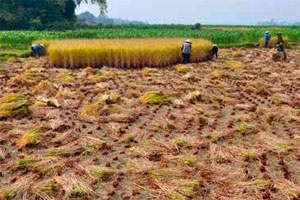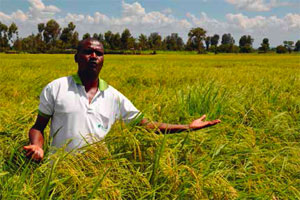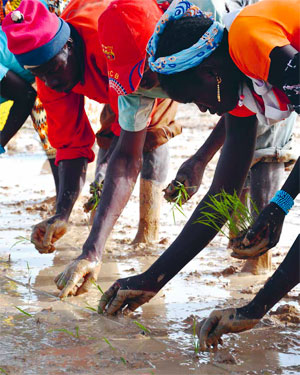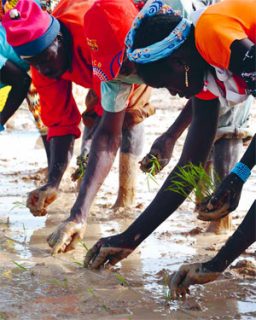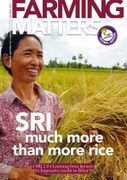Since the first successful SRI results outside Madagascar were reported from Indonesia, India and China in the year 2000, we can distinguish two major periods for SRI. The first period, referred to as SRI 1.0, lasted loosely from 2000 to 2008. The second is proving to be even more interesting.
Transplanting the first SRI plot in Kouin, MaliCurious extension agents, researchers and farmers who learned of SRI set out to determine if this method from Madagascar would show similar results in their own environments.
Side-by-side comparisons were done mostly in farmers’ fields and on a few research plots, where farmer practice or researcher best management practices were compared to SRI practices as described in the extension materials from Madagascar.
The practices included raised bed nurseries, transplanting of young and single seedlings with wide spacing, application of organic matter to soil, alternate wetting and drying irrigation, and mechanical weeding to incorporate weeds and aerate the soil.
SRI 1.0: Curiosity, discovery and controversy
Based on their first field experiences, farmers and technical staff in different countries began to adapt the SRI practices to their own climates and rice growing conditions: ranging from humid to arid climates, from sea-level to high altitudes, and for irrigated, lowland and upland rice systems.
In many countries, excellent results were documented in research reports and field reports, as well as in a few scientific articles. This led to a period of controversy, when a handful of scientists from certain U.S. universities and the International Rice Research Institute (IRRI) questioned the legitimacy of the reported SRI yields and the associated benefits. Unless these results were validated in peer-reviewed scientific journals, the SRI system could not be taken seriously.
This observation about the lack of peer-reviewed scientific articles in this early period was correct, and understandable. More formal SRI research had just gotten underway. Formal agricultural experiments usually take 3-5 years from conception until results are published in a peer-reviewed journal, whereas technical reports can be available shortly after the field tests are finished.
The number of peer-reviewed research articles increased steadily each year. Prior to 2002, fewer than ten articles about SRI were published per year. This increased to 15-30 articles per year during the period 2003-2008, and reached over 60 articles per year by 2011- 2012. As of early 2013, we count a total of more than 350 peerreviewed journal articles about SRI.
Despite the greatly increased number of peer-reviewed journal articles, some observers, especially from scientific circles, have clung to their original objections, seeming to ignore the research and results published over the past decade. In any event, this intellectual controversy has been of little concern to farmers, who have continued to adopt the SRI method in more countries with support from pragmatic practitioners and scientists.
SRI 2.0: Adoption and innovation outpaces formal research
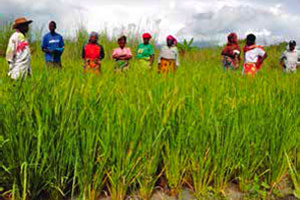
rainfed SRI in Kalengakelu, Morogoro, Tanzania.
All photos by Erika Styger
By 2008, the SRI method had been validated in 38 countries, based on solid fieldwork and research. Positive results were obtained under different ricecropping systems independent of the variety used, and in different climates and agro-ecological zones.
By early 2013, the SRI methodology had been validated in 51 countries. Reports consistently cite yield increases, decreased use of seed, water and agro-chemicals, and increased income.
Although practices vary according to specific rice systems, the underlying core principles for SRI remain the same:
- early and quick establishment of healthy plants,
- maintaining a low plant density to allow optimal development of each individual plant,
- enriching soils with organic matter to improve nutrient and water-holding capacity, increase microbial life in soil, and to provide a good substrate for roots to grow and develop, and
- reducing and controlling the application of water, providing only as much water as necessary for optimal plant development and to favor aerobic soil conditions.
Interestingly, it was resource-constrained smallholder farmers, who depend on agriculture and rice production to feed their families, who have been the most progressive in understanding the potential of SRI. To be able to change agricultural productivity based on their own resources and knowledge has empowered farmers and changed their outlook on what is possible in farming. In contrast to the conventional paradigm of agricultural intensification (“use more inputs to produce more”), farmers could now “produce more with less” – a real alternative and relief for many smallholder farmers. This has created a noticeable push for innovation. Farmers started experimenting in their fields with a fresh open mind, knowing that simple management practices can make all the difference.
Since the year 2005, farmers and technicians in India, Mali, Ethiopia, Nepal, Pakistan, Afghanistan and Cuba, inspired by their success with SRI, have begun – independently from each other – to test the SRI principles with other crops. Improved yields, stronger plants, and an improved quality of the harvest have been reported for crops like finger millet, wheat, sugar cane, mustard, Ethiopian tef, legumes, and vegetables. The application of SRI principles worked also with other crops, thus the System of Crop Intensification, or SCI, was established.
We can observe a similar trend with SCI as happened earlier with SRI. As of early 2013, no peer-reviewed scientific articles on SCI have yet been published, although field reports are available. The most complete collection can be found at the Cornell SRI-Rice website under “Other Crops”.
An example for wheat production in India illustrates this well. We are aware of on-station experiments for the system of wheat intensification (or SWI) at the Indian Agricultural Research Institute (IARI) in New Delhi and at the Indian Council of Agricultural Research (ICAR) in Patna, but no formal articles have been published to date. On the other hand, during the 2011/2012 season, more then 183,000 hectares were planted with SWI in the state of Bihar, achieving an average yield of 4.5 t/ha compared to the traditional 2.4 t/ha for that season.
Because innovation comes from the farmer, SRI and SCI turn the conventional research system approach upside down. It contradicts the still prevalent model where innovations are developed on research stations and “transferred” to farmers. With SRI and SCI, agriculture scientists need to go to farmers’ fields to learn about the innovations. Unfortunately, this is not happening often enough, so most researchers, development professionals, policy makers and donors remain unaware of what farmers’ innovations look like, and are thus unable to support new opportunities to improve food security.
So, how can we learn from these innovating farmers? Who tracks what they do and how is it reported? The press is often the first to make farmers’ results public, as seen in many newspaper articles coming out of India. Still, for many field-based NGOs, reporting farmer SRI and SCI results in a systematic way is not a priority. They tend to focus on responding to donorimposed monitoring indicators and requests for data, and if time allows, prefer to work in the field rather than writing additional reports.
A priority for research should therefore be to develop and implement methodologies that directly track farmer efforts and help to fine-tune their SRI practices and innovations. This can be done
- through an action-research approach,
- by designing “natural experiments” or “observational studies,” under which treatments are not superimposed but data are collected directly from farmers’ fields in a large enough sample size, enabling to track farmers’ specific farming practices, and
- by training farmers and extension agents in data collection and scientific monitoring, enabling them to participate actively in research and directly share their findings.
How did experimental SRI research evolve?
While early research focused on comparison trials of SRI practices with farmer or best management practices, recently more research focuses on understanding the factors that contribute to improved plant performance and phenotype, such as studies of roots, plant physiology, and the influence of microorganisms on plant productivity. Much more research is needed to better understand “what makes SRI tick”.
To date, most research on SRI has been undertaken by nationally-funded programmes, especially in India, China, Thailand, Japan, and Indonesia. International research organisations, including those of the CGIAR system, have done very little.
That institutions in several different countries have undertaken independent SRI research is a plus. Less favorable is that members of this diversified research community tend to work in relative isolation because there is no easy way for them to collaborate, and valuable opportunities for synergy are lost. In order to address these constraints, at SRI-Rice we are developing an international SRI research network, where researchers can connect and collaborate easily with each other through an open-access internet platform.
Integration of agro-ecological approaches
Rethinking how we produce agricultural crops is more pressing than ever, given the fragility of our finite natural resource base, and the threat of climate change. The (New) Green Revolution paradigm, “producing more with more inputs”, is no longer an option.
Ecological approaches for sustainable agriculture intensification still offer much potential for development. With the accumulating evidence that the application of SRI core principles improves productivity not only for rice but also for other crops, the potentials for using the SRI methodology become broader and more relevant.
There is still tremendous opportunity to further integrate the SRI method with other ecological approaches such as conservation agriculture, integrated pest management, and agroforestry, to name a few. Each of these approaches concentrates on a different component within the farming system. Their integration will help to create diverse, healthy and productive farming systems with an improved resilience under a changing climate.
T ext: Erika Styger
Erika Styger works as Director of Programs, SRI International Network and Resources Center (SRI-Rice), Cornell University, Ithaca, New York. E-mail: eds8@cornell.edu.
More information is available at the SRI-Rice website, including an inventory of articles (http://sri.ciifad.cornell.edu/research/journalarticles.html). Readers are invited to become a member of the International SRI Research Network at: http://www.mendeley.com/groups/1178631/system-of-rice-intensification-research-network. The official network launch will be mid-2013.
